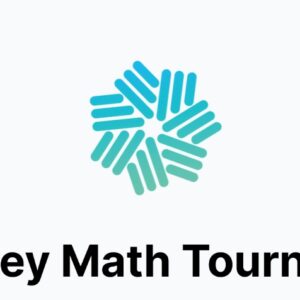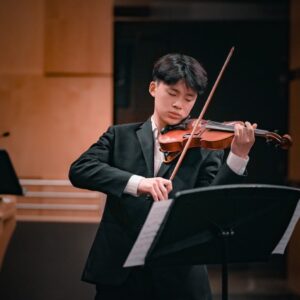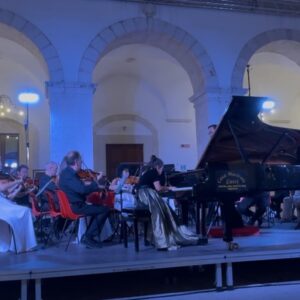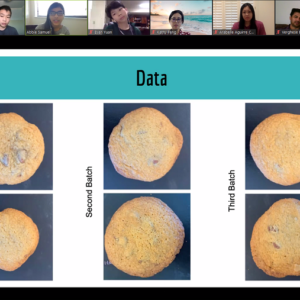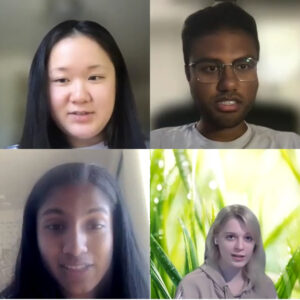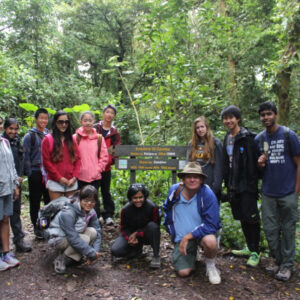This story is a continuation of “Harker Research: Profiles in Perseverance,” a story that appeared in the winter 2014 Harker Quarterly highlighting scientific research being performed by Harker students. Read on to find out more about these students’ fascinating projects and exciting discoveries!
Shikhar Dixit, Grade 12
Shikhar Dixit’s interest in STEM research led him to perform pharmaceutical research at biotech company Cellworks last year. He later discovered that he enjoyed immunology. “I find immunology intriguing because of the interesting intricacies involved,” he said. “When reading research about how the immune system relates to the eye, I became even more interested in pursuing this project.”
For his project, “Immunomodulation by Human Retinal Pigment Epithelial Cell Line ARPE-19,” Dixit was mentored by Dr. Andrew W. Taylor at Boston University Medical Center. “My experience … in the lab environment dealing with fascinating lab equipment and cell cultures while interacting with many Ph.D. and medical students has been the most exciting part of the research,” he said.
Over the course of his research, Dixit found that “there are specific tissues in the body such as the eyes, brain, central nervous system and testes that suppress inflammation in a phenomenon known as immune privilege.”
Matthew Huang, Grade 12
Matthew Huang’s “interest and passion in physics” led him to his research project of quarks and gluons. “I’ve always had a curiosity for how the universe worked at a fundamental level, and researching about quarks and gluons is the perfect subject,” he said.
His project, “Quarks and Gluons in Spacetime: BiCGSTAB Implementation of Lattice QCD on Intel Xeon Phi Coprocessor,” sought to find “a more efficient way to carry out lattice QCD processes, which determine the interactions between quarks and gluons.” One of the most fascinating things he learned was that “you can never separate a pair of quarks, no matter how much energy you put in. Empty space is not actually empty, but filled with oscillating energy fields comprised of gluons.”
Huang’s mentor, William Detmold of MIT, “guided me throughout the entire project and remained supportive through difficulties.”
Leeza Kuo, Grade 12
Leeza Kuo, grade 12, chose stem cells as the subject of her research project, “Embryonic stem cell markers KLf4 and SSEA1 expressed as a result of acute-liver damage,” because of the possible health benefits they offer. “I love to help others and researching stem cells could lead to new regenerative health procedures that could help many people,” she said. “Stem cells are very popular field of research today partially because of the potential it could have on regenerative medicine.”
Being in the research program at Harker afforded Kuo opportunities she may not have had otherwise. “Thanks to [Harker’s] strong science program, I was able to complete my research project using methods including electrophoresis and polymerase chain reaction that are not readily available at most other schools,” she noted.
The extra help sessions she attended at school also helped her understand material more clearly, as it allowed her to review topics with her teachers and ask more pointed questions. “Harker teachers are always extremely supportive and encouraging in their student’s work because of the small faculty to student ratio,” Kuo said. “All my teachers know me by name along with my personality and character.”
What excited Kuo most about her research was the implications it may have for changing how – and how long – people live: “Induced pluripotent stem cells could be the key to reversing aging and repairing genetic mutations by implanting new tissues, becoming the non-fictional fountain of youth.”
Ankita Pannu, Grade 12
Ankita Pannu’s project, “Mining online cancer support groups: improving healthcare through social data,” was special to her for a variety of reasons, but one stands out. “I wanted to do this project after a member in my family was diagnosed with thyroid cancer,” she recalled. “I spent a lot of time in thyroid cancer support groups and I realized that they are really hard to navigate, so I decided to use my knowledge of computer science to solve this problem.”
Pannu’s hope was to make this particular online support group easier to navigate so that thyroid cancer patients will have an easier time finding helpful materials. “I hoped to be able to summarize and categorize threads so that users would be able to easily determine whether it would be valuable for them to read,” she said. “I also tried to find correlations between symptoms and treatments based on what people were discussing.”
In addition to having success in these areas, she said it gave her some ideas for future research she hopes to pursue. The project also gave her a chance to combine her love of computer science and linguistics into a single project.
“I have always been interested in computer science and especially the intersection of linguistics and CS to find meaning in human language,” she said. “It is so fascinating to me that computers are becoming more intelligent systems and we can use different algorithms to make sense out of natural language.”
Archana Podury, Grade 12
Hematology was new for Archana Podury, grade 12, who is working with Stanford University’s Dr. Anu Parla while researching uses for the novel drug CX-5641 for her project, “Targeting Myelodisplasia in 5q- Syndrome Using Novel Drug CX-5641.” Podury has found Dr. Narla to “incredibly helpful.
“When I was becoming familiar with the pathways and the properties of blood cells that were involved with the drug, she decided to hold weekly lectures in her office to teach me segments of confusing material and answer any questions I had.”
Shadowing Narla at a hematology clinic at Lucile Packard Children’s Hospital, Podury had the opportunity to “meet actual patients, study patient samples and learn about blood smears. She always works to contextualize her research and works very closely with her patients, which reinforced to me that research isn’t just a distanced study that happens in a lab, it has actual application for real people.”
Under Narla’s mentorship, Podury, has been considered a real member of the team at the lab. “Since I’m still working in the lab during the school year, she organizes monthly lab meetings discussing everyone’s projects and makes sure I can make it to the meetings,” Podury said. “I’m very thankful to have had her as a mentor; she has helped me so much throughout the process.”
Podury hopes that her work at the lab will reveal that “[CX-5641] can selectively target defective 5q- cells in not just an A549 model, but also in CD34 blood cells and in patient samples. It’s a long way to go, but I’m excited to keep working.”
Because she is not yet 18, Podury is not able to work with core blood, but watching her colleagues process core blood has been one of the most exciting parts of her research. She has also been introduced to techniques that she had not been familiar with previously. “I learned about viral transfections and knocking down segments of DNA using lentivirus, which was especially interesting because we learned about lentivirus in AP Bio, but I never knew something so dangerous could be used so effectively in research,” she said.
Podury’s experience with research began in middle school through the Harker Research Club. Prior to her work at Stanford, she worked at Harker’s Open Lab. “I was able to see many sides of research that I didn’t know about before, like how important the stage of ordering materials is, how unpredictable results can be even when they’re planned very precisely, and how to analyze and respond to errors in data,” she said. “Harker lets us access so many resources, and before working in open lab, I honestly had no idea that the lab had so much high quality equipment that was available to students. It’s really a privilege.”
Sahana Rangarajan, Grade 12
“I wanted to spend my summer at a research internship to gain the experience necessary to conduct research in college,” said senior Sahana Rangarajan.
Her project, “Tracking parallel mutation trajectories conferring increased resistance to HIV-RT inhibitors,” was the result of a newfound interest in biology and programming. “Thus, bioinformatics seemed a perfect field to try research in,” she said.
The goal of the research was to improve ways of predicting how HIV develops mutations that resist drug treatment. In the process, the research team “used a new method that yielded promising results,” Rangarajan said. Interestingly, she added, “there was no lab based component, but learning about the biology behind HIV was necessary for me to understand what I was doing.”
Nikash Sankar, Grade 12
During his work as a volunteer at a dementia care facility, senior Nikash Shankar witnessed the ravages of Alzheimer’s disease firsthand, and wanted to help. “As I was investigating various herbal remedies for Alzheimer’s, I came across curcumin, a spice that is commonly used in Asian cooking,” he said. “Being familiar with the spice, I became interested in its effects on Alzheimer’s disease and possible methods of improving its efficacy.”
Researching further, Shankar discovered he could increase curcumin’s ability to reduce toxicity caused by Alzheimer’s through “encapsulation of curcumin into polymeric nanoparticles.”
Adding to the field of Alzheimer’s research was the most exciting part of his project, titled “A Potential Therapy for Alzheimer’s Disease: Encapsulation of Curcumin within Polymeric PLGA-PEG Nanoparticles Protects Neuro2A cells from Beta-Amyloid Induced Cytotoxicity and Improves Bioavailability.” “Everything we find through our research (that is novel) is something that no one has ever found before and discovering or even validating a scientific finding as a high school student is a rare opportunity,” he said.
Science teachers Chris Spenner, Anita Chetty and other Harker faculty members provided helpful feedback to Sankar as he was creating his paper.
Aside from having a unique research opportunity, Shankar also had the rare chance to use a scanning electron microscope. “SEM’s are incredibly expensive and only very few exist in California,” he said.
Venkat Sankar, Grade 10
Sophomore Venkat Sankar’s interest in environmental science led him to research the environmental impact of the proposed billion-dollar Panoche Valley Solar Farm, which would be constructed in central California’s Panoche Valley if approved.
Sankar said he was “[concerned] about the potential impact of the Panoche [Valley] Solar Farm project on the rare and endangered wildlife in the area.” The main goal of his project, ‘Managing the Impact of Infrastructure Projects on Endangered Species: A Stochastic Simulation Approach Based on Population Viability Analysis,’ was to use computer simulations that would analyze available information and use it to simulate a system, in hopes of coming up with “a detailed assessments of the impact of infrastructure projects on endangered wildlife.”
He received help from middle school science teacher Daniel Sommer, who offered advice and introduced Sankar to an expert in environmental sciences. Upper school science teacher Jeff Sutton also provided input on the final paper.
“It has been validated using a real-life case study in California,” Sankar said of his project. “It is broadly applicable to a range of environmental impact studies around the world.”
Madelyn Wang, Grade 12
After taking Harker’s research methods class in grade 10, Madelyn Wang, now grade 12, became interesting in pursuing scientific research. This past summer, she enrolled at UC Davis’ Young Scholars Program , where she worked on developing a blot procedure for detecting trace amounts of protein in tissue samples with her mentor, Dr. Aldrin Gomes. “I also studied the protein expression levels of GSTM1, an antioxidant enzyme, and looked at if those levels were altered in diabetic and non-diabetic mice,” she said. He project is titled “Optimized Western blotting allows for detection of Glutathione S-Transferase Mu 1 levels in hearts from type I diabetic Akita mice and wild-type mice.”
Overall, Wang said her time spent in the Young Scholars Program “was a great way to get hands-on experience in the lab while living in the dorms and getting a college experience.”
Serena Wang, Grade 12
“I have always been curious and eager to try new things,” said senior Serena Wang of her project, “Coronary Artery Calcification and Cardiovascular Risk Factors in South Asians.” “This project mainly required me to develop my abilities to do statistical analysis, which I had never focused on before.”
Wang drew on her background in computer science to analyze data she had gathered about cardiovascular disease. “Heart disease is a common illness, and I wanted to improve current methods of predicting cardiovascular disease risk,” she said.
Mentored by Ashish Mathur of the South Asian Heart Center at El Camino Hospital, Wang utilized the resources made available to her to identify a specific area of study. “I wish to find a better way to determine cardiovascular disease risk for the South Asian population, which suffers from a significantly higher prevalence of cardiovascular disease than other ethnicities,” she said.
The skills Wang learned at Harker were key to helping her gain a greater understanding of the topic. “After learning so much at school, I am finally able to use the theoretical concepts I learned in school to do novel research,” she said. “The potential effects of my results could help the South Asian Heart Center better predict cardiovascular disease risk and thus more effectively prevent development of the disease.”
Wang’s research gave her the opportunity to pick up new skills, including the use of statistical analysis software. “With such specific syntax and so many different commands, the software was challenging to learn to use efficiently, but now I am experienced enough to even teach a new student researcher how to use the application.”
Samyukta Yagati, Grade 12
During her freshman year, Samyukta Yagati, who has been doing research projects since grade 7, became interested in computer science, a subject she has pursued actively ever since. “Research is a lot of fun for me,” she said. “I enjoy the process, the discovery, the challenge, applying things I’ve learned in class to real-life problems.”
Her project, “Optimizing Segmentation Performance to Improve Diagnosis of Breast Lesions,” gave her the opportunity to explore both computer science and biology, a topic she had recently become enamored with. “I have loved computer science since freshman year, and I’ve been interested in bio. That interest intensified after bio in junior year,” she recalled.
In her research, Yagati hoped to improve an algorithm that is used to diagnose patients with breast lesions. “Improving the results/increasing automation of the process can really help effectiveness and usability of the program in clinics, hopefully improving patient experience and treatment,” she said.
While researching for the project, Yagati learned some interesting things about medical research: “Knowing information as simple as whether the edge of a lesion … is spiky or not can give doctors a lot of information about malignancy!”
Michael Zhao, Grade 11
Amyotrophic lateral sclerosis, perhaps better known by the acronym ALS and the nickname Lou Gehrig’s disease, received a lot of attention this past summer due to the craze created by the Ice Bucket Challenge.
Junior Michael Zhao’s own research began after he read numerous articles on the topic. “Especially over the summer, with the ALS Ice Bucket Challenge, I felt like my research had a tangible impact and made the experience more interesting,” he said.
Zhao’s project, “A Yeast Functional Screen Elucidates Potential Mechanisms of C9ORF72 RAN Protein Toxicity in ALS Pathogenesis,” involved searching for genetic modifiers for RAN proteins. “RAN proteins, the focus of my research, were first identified in 2011,” he said. “Yet, three years later, we still know very little about the underlying mechanisms of RAN protein toxicity.”
Zhao worked with a mentor that he said was extremely helpful. “My mentor has taught me many techniques to perform experiments, he said. “Furthermore, he offered me an experience I could never have hoped to obtain elsewhere.” Working in a university lab was also a new and exciting experience, which offered many learning opportunities.
In addition, he received a lot of help from Harker science teachers in refining his project. “In particular, they were very helpful in reading over my paper and giving me feedback,” he said.

